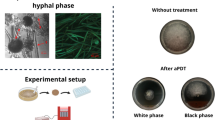Abstract
In a previous study with airborne mould extracts we verified thatDrechslera (Helminthosporium) monoceras presented stronger reactions than those presented by 42 other moulds isolated in São Paulo city. In the present study, we evaluated the biochemical composition and the antigenicity of crude extracts obtained from vegetative and conidial stage ofD. monoceras using Czapeck broth (CB) modified and tris-HCl for extraction. The maximum values of total proteins and lipids were verified in the crude extract obtained in the 28th day of growth, and maximum values of carbohydrates were observed in the extracts of the 16th, 22nd and 26th days. The fractionated proteins by SDS-PAGE presented bands with molecular weights between 14.4 to 67 Kd; the 28th day extract showed a larger number of bands. The carbohydrates and amino acids were characterized by thin-layer chromatography. The antigenicity of the crude extracts was verified by immunodiffusion reaction in agar against rabbit hyperimmune sera. Precipitation lines were observed in all studied extracts and common antigenic molecular populations. Based on the above results, the 28th day extract was selected to verify the induction of IgE antibody responses in immunizations of Balb/c and cAF-1 mice, and titer by passive cutaneous anaphylaxis test using Wistar rats. The maximum titers obtained were 160 in cAF-1 mice and 1.280 in Balb/c mice. The results suggest that the 28th day extract contains allergenic fractions and should be chosen for future studies related to fractionation, characterization and standardization in diagnostic methods and immunotherapy.
Similar content being viewed by others
References
Gambale W, Porchio A, Croce J. Flora fúngica anemófila da grande São Paulo. Rev Microbiol 1977; 8: 74–9.
Mohovic J, Gambale W, Croce J. Cutaneous positivity in patients with respiratory allergens to 42 allergenic extracts of airborne fungi isolated in São Paulo, Brazil. Allergol Immunopathol 1988; 16: 397–402.
Barron, GL. The genera of Hyphomycetes from soil. In: Robert E. Krieger, ed. New York: Hunntington, 1972.
Yunginger JW. Allergens: recent advances. Pediatric Clin N Ann 1988; 35: 981–93.
Wortmann F. Diagnostico y tratamiento de las alergias de tipo I producidas por los esporos fungicas. In: Reciones immunologicas frente a los antigenos fungicos. Division de alergia, Merck-Ioga; Espana, pp. 4–43; 1962.
Yunginger JW, Jones RT, Neisheim ME, Geller M. Studies onAlternaria allergens. III — isolation of a major allergenic fraction (Alt-1). J Allergy Clin Immunol 1980; 66: 138–47.
Scott TA, Melvin EH. Determination of dextran with antrona. Ann Chem 1953; 25: 1956–61.
Lowry OH, Rosebrough NJ, Farr AL, Randall RJ. Protein measurement with the Folin-phenol reagent. J Biol Chem 1951; 193: 265.
Frings SW. Determination of lipids. Clinical Chem 1972; 18: 673–9.
Nichols AV, Kraus RM, Nushiner TA. Nodernaturing polyacrilamide gradient gel electrophoresis. Methods Enzymol 1966; 128: 417–31.
Sih VE. Laboratory techniques for the detection of hereditary metabolic disorders. Londres, CRC Press; 1973.
Ouchterlony O. Antigen antibody reactions in gels. IV — Types of reactions in coordinated systems of diffusion. Acta Pathol Microbiol Scand 1953; 32: 231–40.
Bouziane H, Latge JP, Mecheri S, Fitting C, Prevost MC. Release of allergens fromCladosporium conidia. Int Arch Allergy Appl Immunol 1989; 88: 261–6.
Mota I, Wong D. Homologous passive cutaneous anaphylactic activity of mouse antisera during the course of immunization. Life Sci 1969; 8: 813–20.
Ford A. Characterization of moulds. In: Purification y estandardization de alergenos, Madri; 1982, pp. 43–53.
Agarwal MK, Jones RT, Yunginger JW. Shared allergenic and antigenic determinants inAlternaria andStemphylium extracts. J Allergy Clin Immunol 1982a; 70: 432.
Agarwal MK, Jones RT, Yunginger JW. Immunochemical and physicochemical characterization of commercialAlternaria extracts: a model for standardization of mould allergen extracts. J Allergy Clin Immunol 1982b; 70: 433–6.
Aukrust L.Cladosporium herbarum. In: T Foucard, S Dreborg, eds. Mould allergy workshop. Uppsala, Sweden; 1964.
Chang ZN, Lin CY, Tsai LC, Perng RI, Han SH. Allergenic components ofAspergillus fumigatus determined by radioimmunoprecipitation. J Asthma 1991; 2813: 213–20.
Sward-Nordmo N, Almeland TL, Aukrust L. Variability in different strains ofCladosporium herbaruim with special attention to carbohydrates and contents of two importante allergens (Ag-32 and Ag-54). Allergy 1984; 39: 398–94.
Unterkircher CS. Antigenos deParacoccidioides brasiliensis e sua applicação no diagnóstico sorológico de Paracoccidioidomicose. São Paulo, 1988 (Tese de Doutorado — Escola Paulista de Medicina).
Schumacher MJ, Jeffery S. Variability ofAlternaria alternata: biochemical and immunological characteristics of culture filtrates from seven isolates. J Allergy Clin Immunol 1976; 58: 263–77.
Kaufmann HF, van der Heide S, Beaumont F, de Monchy JGR, de Vries K. The allergenic and antigenic properties of spore extracts ofAspergillus fumigatus: a comparative study of spore extracts with mycelium and culture filtrate extracts. J Allergy Clin Immunol 1984; 73: 567–73.
Alonso A, Scavini LM, Mouchian NK, Rodriguez SM, Iraneta SG. Antigenicity ofPenicillium notatum in animals and in atopic patients. Allergol Immunopathol 1990; 816: 301–7.
Landmark E, Aukrust L. High performance liquid chromatography ofCladosporium herbarum. Identification of allergens with immunological techniques. Int Archs Allergy Appl Immunol 1985; 78: 731–6.
Aukrust L, Borch SM. Partial purification and characterization of twoCladosporium herbarum allergens. Int Archs Allergy Appl Immunol 1979; 60: 68–79.
Budd TW, Norn S, Lichtenstein L, Hoffman D, Norman P. The isolation of a unique basic peptide allergen fromAlternaria extracts. J Allergy Clin Immunol 1981; 69: 145.
Author information
Authors and Affiliations
Additional information
Part of the thesis of E.A. Menezes to get degree of Doctor “Fractionation and characterization of allergenic extract ofDrechslera (Helminthosporium) monoceras”.
Rights and permissions
About this article
Cite this article
Menezes, E.A., Gambale, W., Macedo, M.S. et al. Biochemical, antigenic and allergenic characterization of crude extracts ofDrechslera (Helminthosporium) monoceras . Mycopathologia 131, 75–81 (1995). https://doi.org/10.1007/BF01102882
Received:
Accepted:
Issue Date:
DOI: https://doi.org/10.1007/BF01102882




